Meet the New Powerful Russian Sarmat ICBM
by Fabio Giuseppe Carlo Carisio for VT Europe
A few months ago the superb President of Ukraine Volodymyr Zelensky spread the word that Russian President Vladimir Putin had run out of missiles. Between Monday and Tuesday, the retaliation of Russian aviation with hundreds of missiles on the capital Kiev and other Ukrainian cities, in response to the explosive attack on the Kerch bridge for who has blamed the Kiev intelligence, has severely denied him.
But for weeks now there has been talk of the nuclear nightmare due to a decree signed two years ago by Putin which provides for the use of tactical atomic weapons also in response to attacks with conventional weapons on Russian territory, already hit several times by rockets from Kiev in the border areas. The issue has become even more alarming after the annexation to the Russian Federation of the Ukrainian regions of Donetsk, Lugansk, Kherson, and Zaporizhzhia as, logically, the same justification to use nuclear weapons could apply to these territories as well.
Well, according to the Federation of American Scientists, Moscow, contrary to what the habitual liar Zelensky says, possesses 5,977 nuclear warheads: 549 more than the US according to these official sources, and 2 thousand according to the unofficial ones.
According to Martin Armstrong of Statista, nine countries are thought to now have close to 13,000 nuclear warheads.
The United States and Russia are at the top of the list, as compiled by the Federation of American Scientists (FAS), with a combined arsenal of nearly 11,000 weapons. “Instead of planning for nuclear disarmament, the nuclear-armed states appear to plan to retain large arsenals for the indefinite future,” the FAS said in late 2021. “All continue to modernize their remaining nuclear forces… and all appear committed to retaining nuclear weapons for the indefinite future.”
A nuclear war “cannot be won and must never be fought,” the United States, Russia, China, the UK, and France unanimously agreed in January, in a rare instance of agreement on a matter of international security. A senior U.S. State Department official at the time described the vow, the outcome of months of negotiations, as “an acknowledgment that it is something that we want to avoid.”
NATO Member States set to hold Nuclear Deterrence Drills starting Next Week
US NUCLEAR WEAPONS IN EUROPE
Nuclear weapons owned by the United States have been deployed in Europe since the mid-1950s when President Dwight D. Eisenhower authorized their storage at allied North Atlantic Treaty Organization (NATO) bases on the continent for use against the Soviet Union. Though NATO officially declares itself a “nuclear alliance,” it does not own any nuclear weapons. Instead, a small number of bombs are reportedly kept under U.S. Air Force guard at six airbases in five European countries, ready to be delivered by respective national fighter planes.
This was explained by a report by the Center for Arms Control and Non-Proliferation
WEAPONS LOBBY – 6. Third World War Warnings! UK, Nato, US & Zelensky threaten Russia and China
Today, under NATO’s nuclear sharing program, the bombs complement the alliance’s collective security deterrent against threats, principally Russia. Alongside NATO member the United Kingdom’s arsenal, U.S. nuclear weapons in Europe are consistent with Article V of the North Atlantic Treaty. Fellow member France, who re-joined the alliance in 2009, does not commit its own nuclear arsenal to the alliance’s extended deterrent.
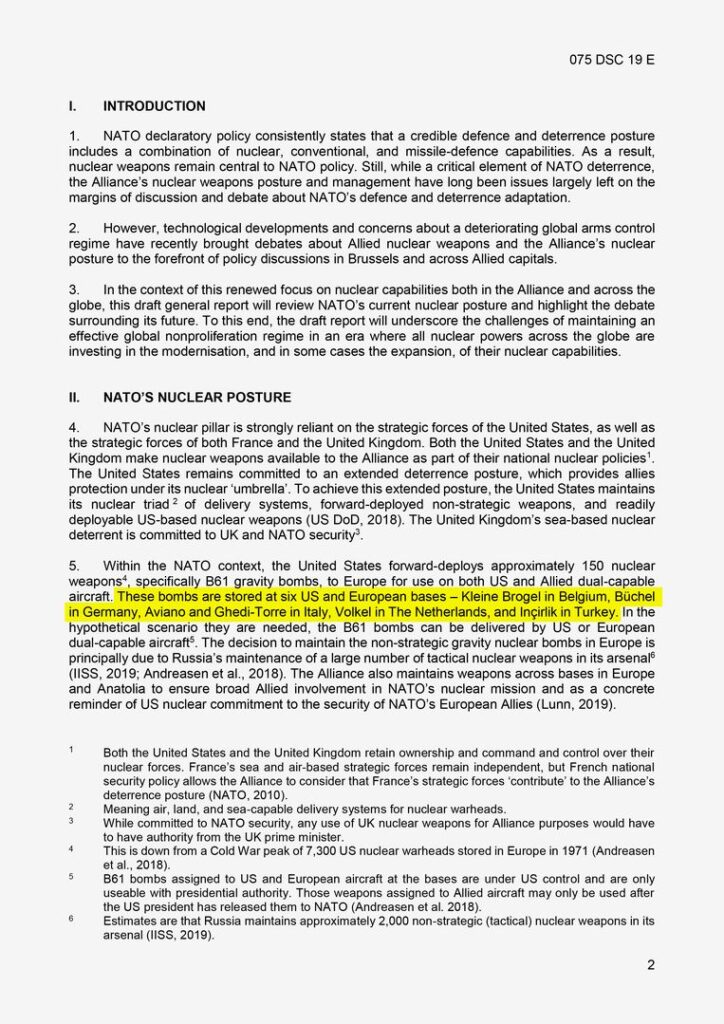 ‘A new era for nuclear deterrence? Modernization, arms control, and allied nuclear forces “, an official document of NATO published by the Belgian Newspaper DeMorgen
‘A new era for nuclear deterrence? Modernization, arms control, and allied nuclear forces “, an official document of NATO published by the Belgian Newspaper DeMorgen
Beyond the alliance’s three nuclear powers, five others participate in U.S. nuclear sharing: Belgium, Germany, Italy, the Netherlands, and Turkey. Seven more participate in the Support of Nuclear Operations With Conventional Air Tactics (SNOWCAT), providing assistance in nuclear missions through conventional air support: Czech Republic, Denmark, Greece, Hungary, Norway, Poland, and Romania.
All 30 members of the alliance excluding France are also a part of the Nuclear Planning Group, which discusses policy issues. The North Atlantic Council remains NATO’s ultimate authority, and member states retain control over their own nuclear forces Center for Arms Control and Non-Proliferation wrote.
HOW MANY
The United States and its NATO allies do not disclose exact figures for its European-deployed stockpiles.
In 2021, it is estimated that there are 100 U.S.-owned nuclear weapons stored in five NATO member states across six bases: Kleine Brogel in Belgium, Büchel Air Base in Germany, Aviano and Ghedi Air Bases in Italy, Volkel Air Base in the Netherlands, and Incirlik in Turkey according to the Center for Arms Control and Non-Proliferation that quoted Federation of American Scientists. But the Nato paper shows that they are almost 150.
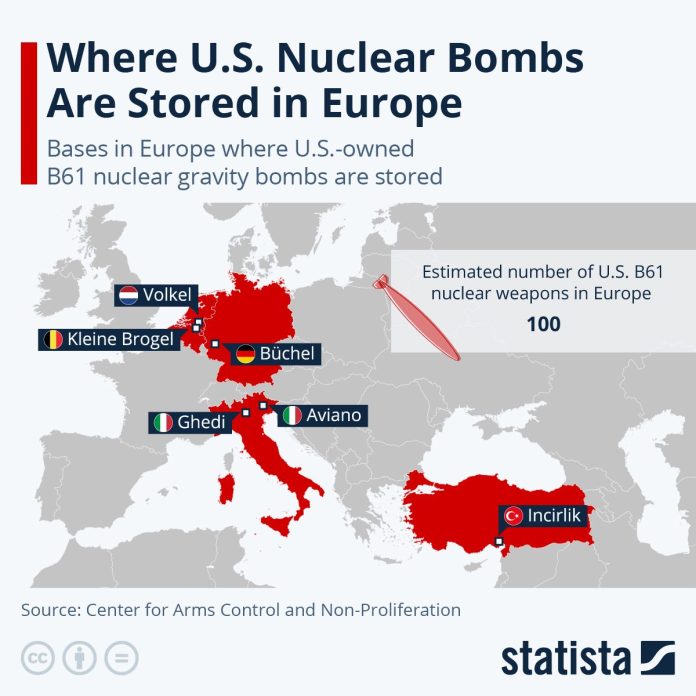
The weapons are not armed or deployed on aircraft; they are instead kept in WS3 underground vaults in national airbases, and the Permissive Action Link (PAL) codes used to arm them remain in American hands. To be used, the bombs would be loaded onto dual-capable NATO-designated fighters. Each country is in the process of modernizing its nuclear-capable fighters to either the F-35A, the F-18 Super Hornet, or the Eurofighter Typhoon.
The total number of nuclear weapons based in Europe reached an all-time peak of 7,300 during the height of Cold War tensions in 1971. The 98% reduction to today’s stockpile reflects the end of Cold War hostilities as well as shifting American defense priorities. The weapons are an important symbol of the U.S.’ longstanding security commitments to Europe, but questions have been raised about the desire of European countries to continue hosting WMDs.
U.S. nuclear weapons in Europe consist entirely of B61-3 and -4 gravity bombs deployed by dual-capable aircraft. Now undergoing modernization under the NNSA’s B61-12 Life Extension Plan, updated warheads are scheduled for deployment by 2024 alongside delivery vehicle modernization programs of host nations. This B61-12 variant will include a new tail kit to improve both efficiency and accuracy. It will also allow variable yield capability, with a yield ranging from 0.3 KT to 170 KT, and allow for both strategic and tactical use.
THE OTHER NUCLEAR COUNTRIES IN EUROPE
Two other NATO members, France and the United Kingdom, also possess their own nuclear arsenals. They have several hundred nuclear weapons each – far fewer than the nuclear superpowers. France has both submarine-launched nuclear missiles and airplane-launched nuclear cruise missiles; the United Kingdom has only submarine-launched nuclear weapons. Both countries have publicly disclosed the size and nature of their arsenals, but neither country is or has been a party to U.S.-Russian arms control agreements.
The U.S., U.K., and France protect other NATO allies under their “nuclear umbrellas” in line with the NATO commitment that an attack on any one ally will be viewed as an attack on the entire alliance.
ATOMIC WARHEADS IN THE WORLD
Both Russia and the U.S. have thousands of nuclear weapons, most of which are five or more times more powerful than the atomic bombs that leveled Hiroshima and Nagasaki in 1945. These include about 1,600 weapons on standby on each side that are capable of hitting targets across the globe» according to an article by Laura Hood for The Conversation (Academic rigor, journalistic flair).
Those numbers are near the limits permitted under the 2011 New Strategic Arms Reduction Treaty, often called “New START,” which is the only currently active nuclear arms control treaty between Russia and the U.S. Their arsenals include intercontinental ballistic missiles, better known as ICBMs, and submarine-launched ballistic missiles, as well as missiles launched from specialized aircraft. Many of those missiles can be equipped with multiple nuclear warheads that can independently hit different locations.
To ensure that countries follow the limits on warheads and missiles, the treaty includes methods for both sides to monitor and verify compliance. By 2018, both Russia and the U.S. had met their obligations under the New START, and in early 2021 the treaty was extended for five more years.
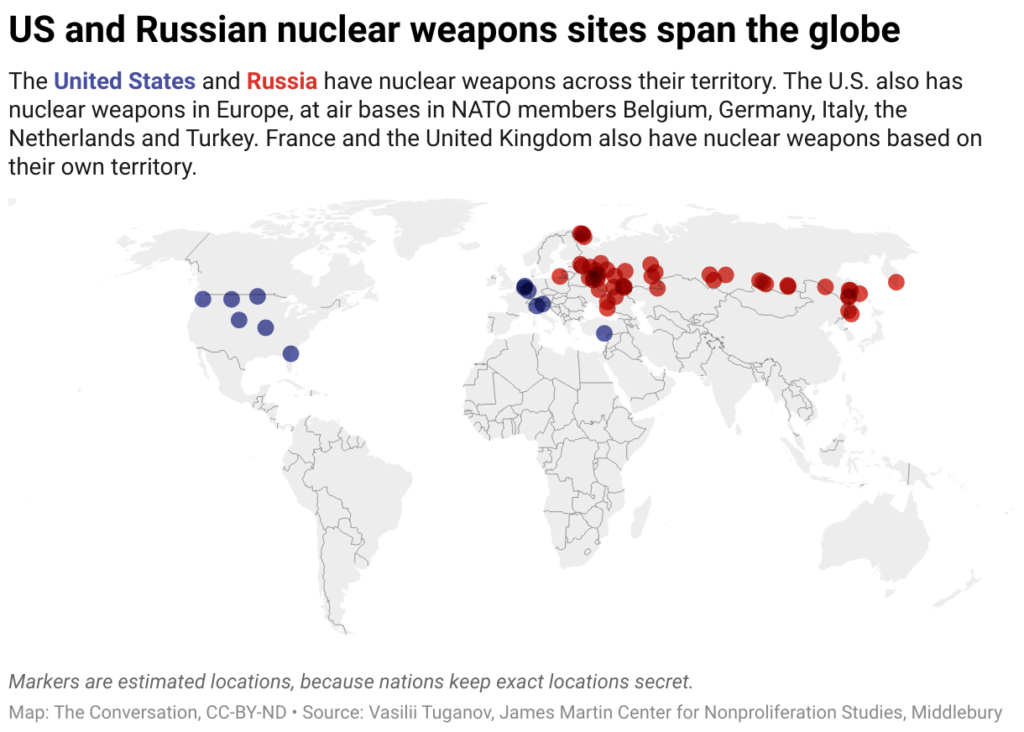
Both nations’ nuclear arsenals also include hundreds of shorter-range nuclear weapons, which are not covered by any treaty. Currently, Russia has nearly 2,000 of those, about 10 times as many as the United States, according to the most widely cited nongovernmental estimates Laura Hood wrote.
China’s nuclear arsenal is currently similar in size to the U.K. and French arsenals. But it’s growing rapidly, and some U.S. officials fear China is seeking parity with the United States. China, France, and the U.K. are not subject to any arms control treaties.
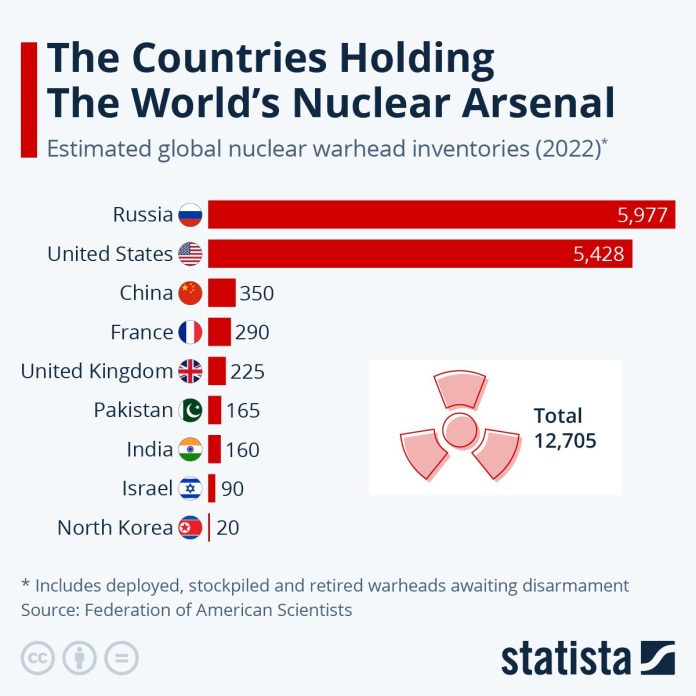
India, Pakistan, and Israel have dozens of nuclear weapons each. None of them has signed the Treaty on the Non-Proliferation of Nuclear Weapons, in which signatories agree to limit the ownership of nuclear weapons to the five permanent members of the U.N. Security Council, each of which possessed nuclear weapons before it was signed.
North Korea, which also has dozens of nuclear weapons, signed that treaty in 1985 but withdrew in 2003. North Korea has repeatedly tested nuclear weapons and the missiles to carry them.
THE RUSSIAN SARMAT ICBM IS READY
The intercontinental ballistic missile Sarmat carries maneuvering warheads, the CEO of the JSC Makeyev Design Bureau (an affiliate of Roscosmos) Vladimir Degtyar, has told TASS.
An intercontinental ballistic missile (ICBM) is a ballistic missile with a range greater than 5,500 kilometers (3,400 mi), primarily designed for nuclear weapons delivery (delivering one or more thermonuclear warheads). Conventional, chemical and biological weapons can also be delivered with varying effectiveness, but have never been deployed on ICBMs.
Most modern designs support multiple independently targetable reentry vehicles (MIRVs), allowing a single missile to carry several warheads, each of which can strike a different target. Russia, the United States, China, France, India, the United Kingdom, and North Korea are the only countries known to have operational ICBMs.
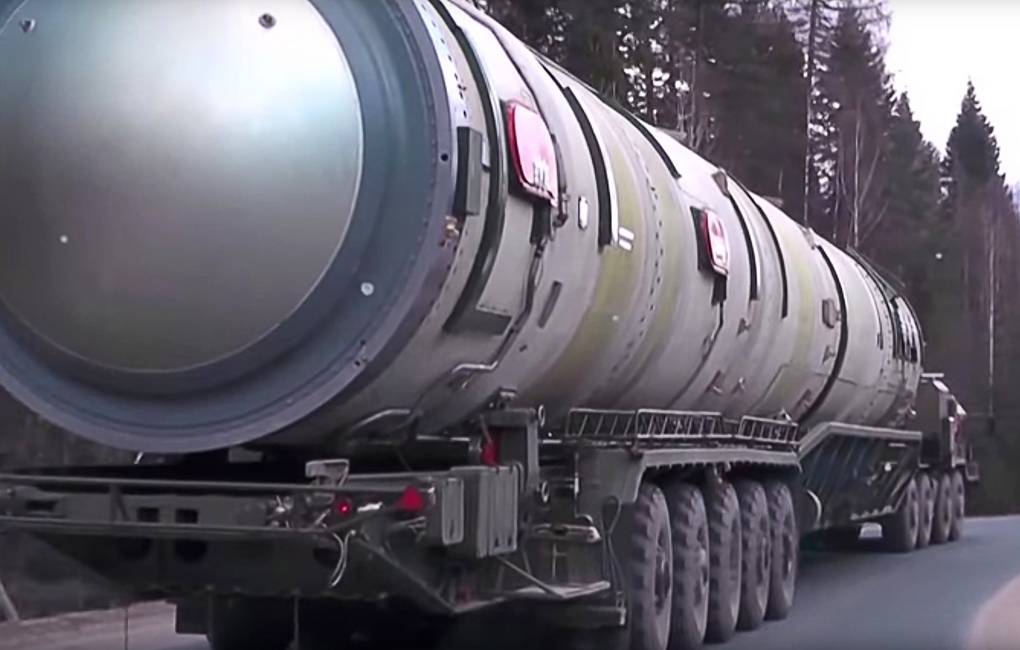
“The Sarmat is equipped with the most advanced maneuvering warheads,” Degtyar said. The missile is unique in terms of its unsurpassed speed, record-breaking range, highest accuracy, and complete invulnerability while penetrating anti-missile defense systems.
Degtyar said the Sarmat intercontinental ballistic missile would be able to leave the silo under any conditions. “According to its current characteristics, the missile will leave its silo under any conditions and fulfill its task with 100 percent certainty. This is what its reliability margin is like,” Degtyar said.
In June, he told TASS that the silo for the Sarmat was a complex engineering structure that guaranteed the missile’s security against strikes with conventional high-precision weapons and nuclear ones.
Degtyar described the Sarmat as the “crowning achievement” in rocket technology the Makeyev center accomplished in cooperation with a cluster of subordinate enterprises. This newest missile system will reliably ensure the security of Russia from external threats for 40-50 years to come, Degtyar believes.
“In today’s adverse geopolitical conditions, it is our impregnable shield, the main factor of nuclear deterrence and a guarantee of peace,” he added. Degtyar recalled that the Sarmat would replace the Voyevoda system, which was created back in the Soviet era.
The new missile, he stressed, is not an analog, but a new generation ICBM with colossal performance characteristics. “That is why it has already been dubbed an ‘engineering miracle’ and the ‘crowning achievement in rocket technology,” Degtyar said.
SARMAT’S CHARACTERISTIC
The Sarmat ICBM was developed at the JSC Makeyev Design Bureau and manufactured at the Krasmash plant (both are affiliates of Roscosmos). According to experts, the RS-28 Sarmat ICBM is capable of delivering a MIRV of up to 10 tonnes to any point on the globe. Its first launch was from the Plesetsk cosmodrome in the Arkhangelsk region on April 20. The test was successful. The design characteristics were confirmed at all stages of the rocket’s flight path.
Fabio Giuseppe Carlo Carisio
© COPYRIGHT GOSPA NEWS
prohibition of reproduction without authorization
follow Gospa News on Telegram
MAIN SOURCES
Source

Fabio is Director and Editor of Gospa News; a Christian Information Journal.
Fabio Giuseppe Carlo Carisio, born on 24/2/1967 in Borgosesia, started working as a reporter when he was only 19 years old in the alpine area of Valsesia, Piedmont, his birth region in Italy. After studying literature and history at the Catholic University of the Sacred Heart in Milan, he became director of the local newspaper Notizia Oggi Vercelli and specialized in judicial reporting.
For about 15 years he is a correspondent from Northern Italy for the Italian newspapers Libero and Il Giornale, also writing important revelations on the Ustica massacre, a report on Freemasonry and organized crime.
With independent investigations, he collaborates with Carabinieri and Guardia di Finanza in important investigations that conclude with the arrest of Camorra entrepreneurs or corrupt politicians.
In July 2018 he found the counter-information web media Gospa News focused on geopolitics, terrorism, Middle East, and military intelligence.
His articles were published on many international media and website as SouthFront, Reseau International, Sputnik Italia, United Nation Association Westminster, Global Research, Kolozeg and more…
His investigations was quoted also by The Gateway Pundit, Tasnim and others
He worked for many years for the magazine Art & Wine as an art critic and curator.
ATTENTION READERS
We See The World From All Sides and Want YOU To Be Fully InformedIn fact, intentional disinformation is a disgraceful scourge in media today. So to assuage any possible errant incorrect information posted herein, we strongly encourage you to seek corroboration from other non-VT sources before forming an educated opinion.
About VT - Policies & Disclosures - Comment Policy





I like the RA 115 portable pocket nuke ! 6 Mt strong or was it 6 kilo tone ? !
I am Afraid of each suite case , which is carried by a scientist of 60s ! Many of them hidden in ISISrael and USrael for in case !
That Sarmat is scary nuke. It can come from behind the DEW line and is virtually unstoppable by ground based defenses.
Perfect ICBM to chill hot heads. 200 tonnes of hi-tech weight. Of course I’d like it never being in direct usage.
IT MAKES PEACE A WIN AND TRUTH FOLLOWS TRUTH BY DEFAULT
Comments are closed.